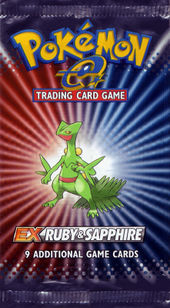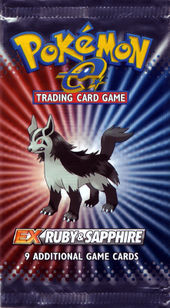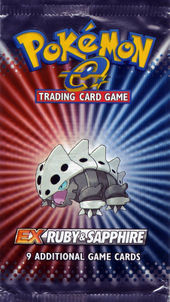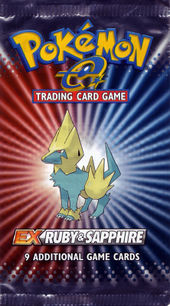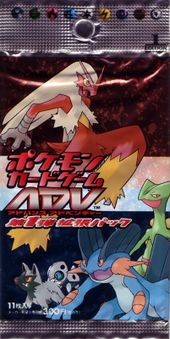From Bulbapedia, the community-driven Pokémon encyclopedia.
- This article is about the Pokémon Trading Card Game expansion. For the core series games, see Pokémon Ruby and Sapphire Versions.
EX Ruby & Sapphire
拡張パック
|

|
|
|
|
Pokémon-e TCG: EX Ruby & Sapphire (Japanese: 拡張パック Expansion Pack) is the name given to the first main expansion of cards from the EX Series of the Pokémon Trading Card Game (the ADV Era in Japan). The set is the first to feature Generation III Pokémon and Pokémon-ex in the card game.
Blurb
Calling All Pokémon Trainers!
Capture and train more than 40 brand-new Pokémon, liven up your battles with new Poké-Powers and new 2-on-2 Battles, and become the Pokémon Champion of a whole new world!
Information
EX Ruby & Sapphire is the name given to the first main expansion of the EX Series of the Pokémon Trading Card Game. In Japan, it was released as Expansion Pack, the first expansion in the Pokémon Card Game ADV Era. It is based on Pokémon Ruby and Sapphire, featuring Generation III Pokémon. The English expansion was released on June 18, 2003, while the Japanese expansion was released on January 31, 2003.
EX Ruby & Sapphire introduced Pokémon-ex, a type of Pokémon. Pokémon-ex are significantly stronger Pokémon. When a Pokémon-ex is Knocked Out, the opponent takes two Prize cards instead of one. Pokémon-ex have Holofoil borders.
EX Ruby & Sapphire also introduced an updated card design, which included numerous changes. The border on the left returned to normal, while the border on the bottom remained thicker to retain the necessary space for the Dot-Code strip (only the Pokédex entry was displayed when scanned). There were several circles on the left of the card. The artwork window and Evolution box were changed from gold to silver. The Evolution box, Stage and illustrator information were moved below the artwork window. The Energy symbols for attacks were smaller and were presented linearly. The copyright information moved to the center on the bottom of the card, so did the unique ID number. For EX Ruby & Sapphire, the text for attacks, Poké-Powers, or Poké-Bodies was now displayed in a new line, separate from the name. For Expansion Pack, the left and bottom borders returned to normal and were changed to silver.
At the time of this expansion's release, numerous rule changes in the Pokémon Trading Card Game took place. Retreating was limited to once per turn; previously, retreating could be performed as often as a player liked during their turn. A Confused Pokémon would put 3 damage counters on itself if it tried to attack and the coin flip was tails, instead of doing 20 damage to itself (affected by Weakness and Resistance). If a player took a mulligan, the opponent now could only draw 1 card, instead of 2, for each mulligan. The opening coin flip was now performed after setup, and if it was heads, the player that flipped the coin was required to go first. During that player's first turn, they were not allowed to draw a card at the beginning or play a Supporter card.[1]
EX Ruby & Sapphire was the first expansion to be distributed by Nintendo of America. In Japan, this was the first expansion to have pre-constructed Half Decks released alongside it.
Set lists
Gallery
|
|
|
|
|
|
|
Japanese Expansion Pack
pack
|
|
|
|
|
|
|
|
|
|
|
|
|
|
|
|
|
|
|
|
Languages this set is released in
The ADV Expansion Pack set is released in both Japanese and Korean. The Japanese set was available in both 1st and unlimited edition, and the Korean set was only printed in 1st edition. The EX Ruby & Sapphire set is released in English, French, German, Italian, Spanish, and Portuguese, with cards also available as Reverse Holos. The non-holo Uncommons in the Japanese, English, French, German, Italian, Spanish, and Portuguese sets are available with two different codes at the bottom-left; the non-holo Commons in the Japanese set are available with four different codes at the bottom-left; and the non-Holo Commons in the English, French, German, Italian, Spanish, and Portuguese sets have three different codes available. The Korean cards only had a single code available for all the cards. The purpose of these different codes is still unknown, but occurred throughout the first half of the EX era.
In other languages
External links
References

